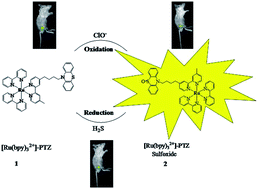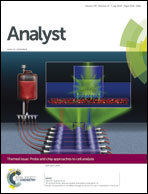Reversible and selective luminescent determination of ClO−/H2S redox cycle in vitro and in vivo based on a ruthenium trisbipyridyl probe†
Abstract
A rapid and highly selective luminescent probe has been developed to determine the in vitro and in vivo ClO−/H2S redox cycle using a ruthenium tris-bipyridyl complex covalently linked with phenothiazine. The luminescence intensity was considerably enhanced upon the addition of ClO− due to the oxidation of the probe to its sulfoxide derivative, which quickly returned to the original level by the reaction with H2S due to the reconstitution of the probe. The redox cycle can be repeated at least 12 times. Under optimal conditions, the luminescence intensities are linear over the concentration range of 1 × 10−9 to 1 × 10−4 mol L−1 for ClO− and 1 × 10−9 to 1 × 10−4 mol L−1 for H2S, and the detection limits are 1.8 × 10−11 mol L−1 for ClO− and 1.2 × 10−11 mol L−1 for H2S, which are much lower than those obtained with other detection methods. The proposed method is simple in design and fast in operation, and is suitable for the reversible determination of ClO− and H2S in vitro and in vivo with high selectivity.

- This article is part of the themed collection: Probe and chip approaches to cell analysis

 Please wait while we load your content...
Please wait while we load your content...